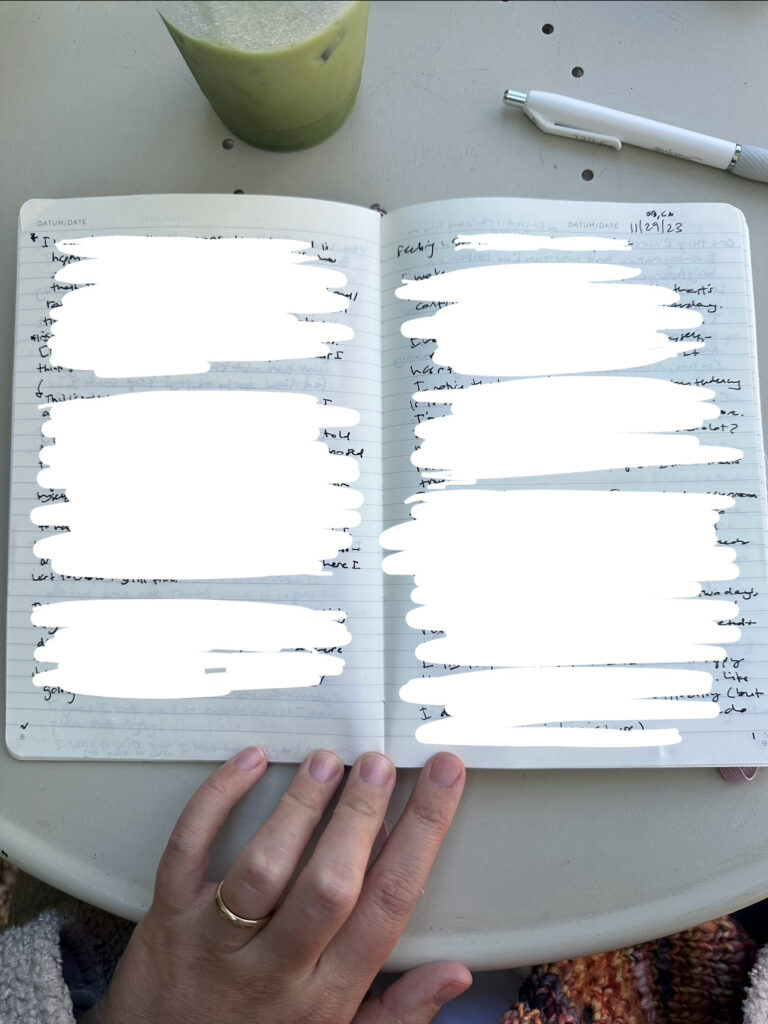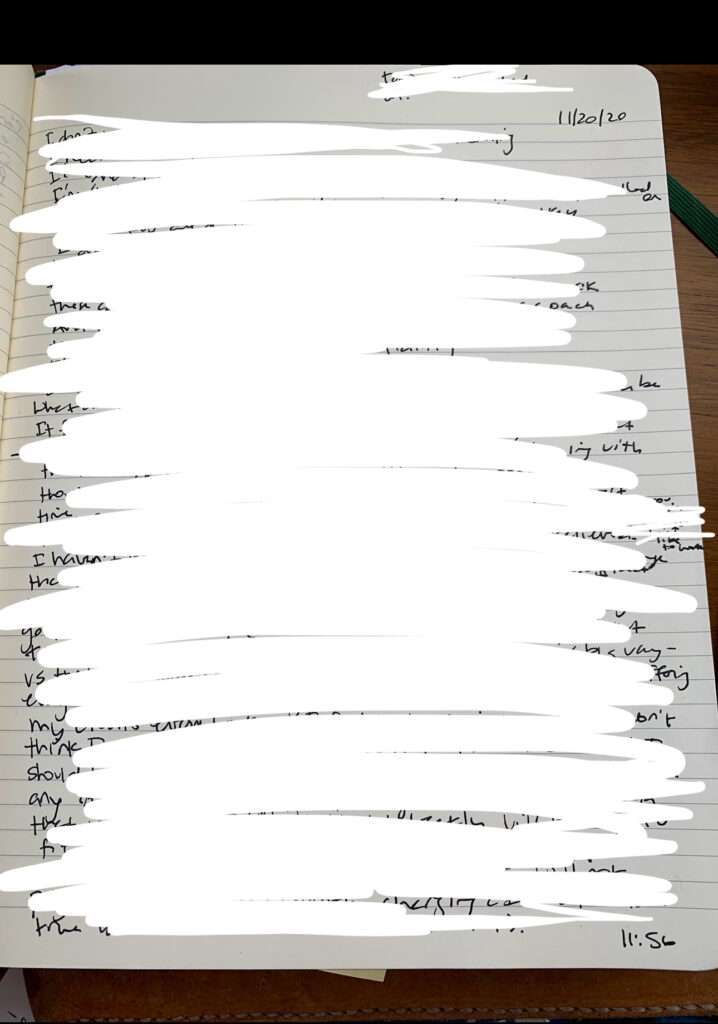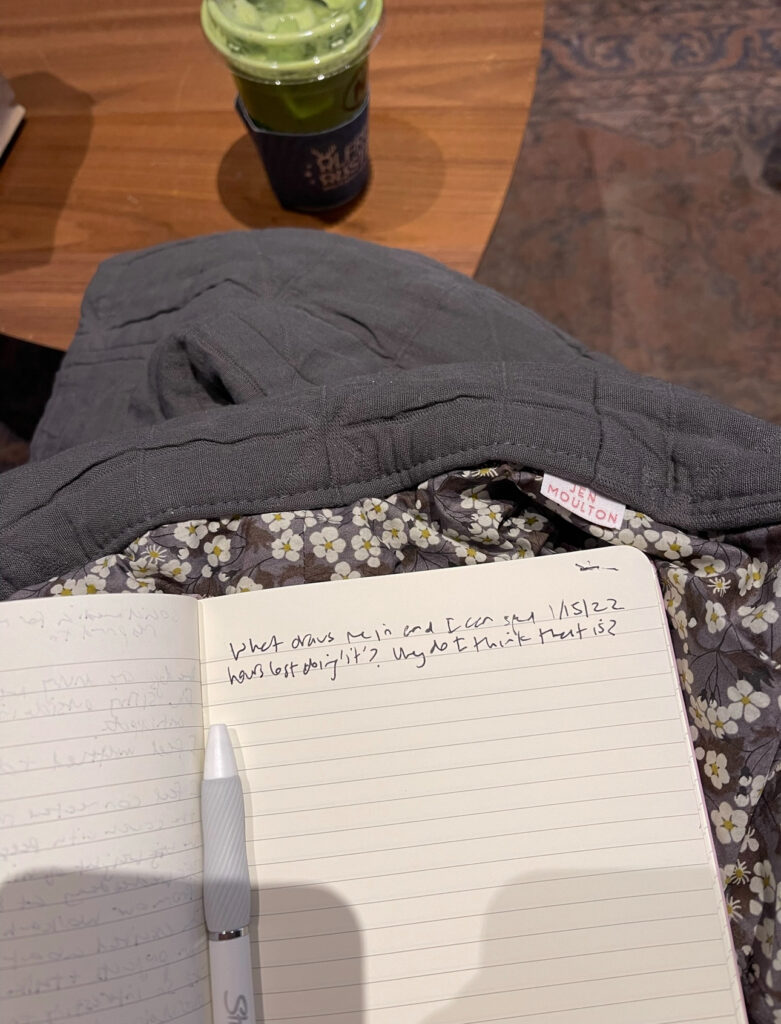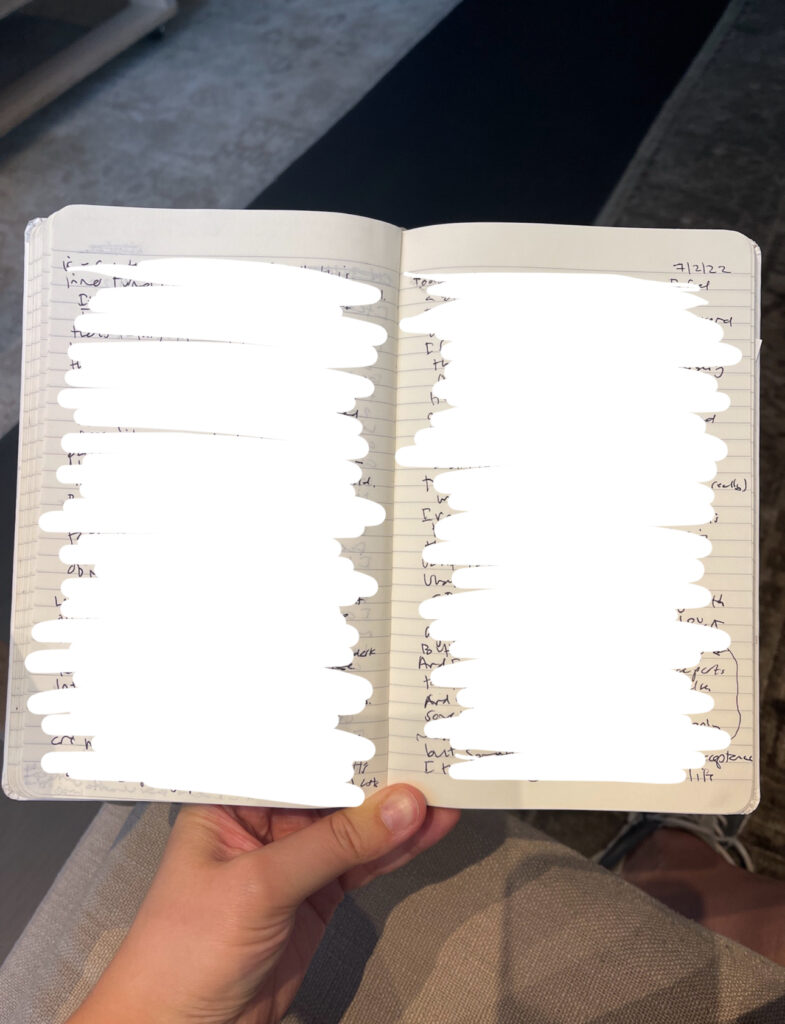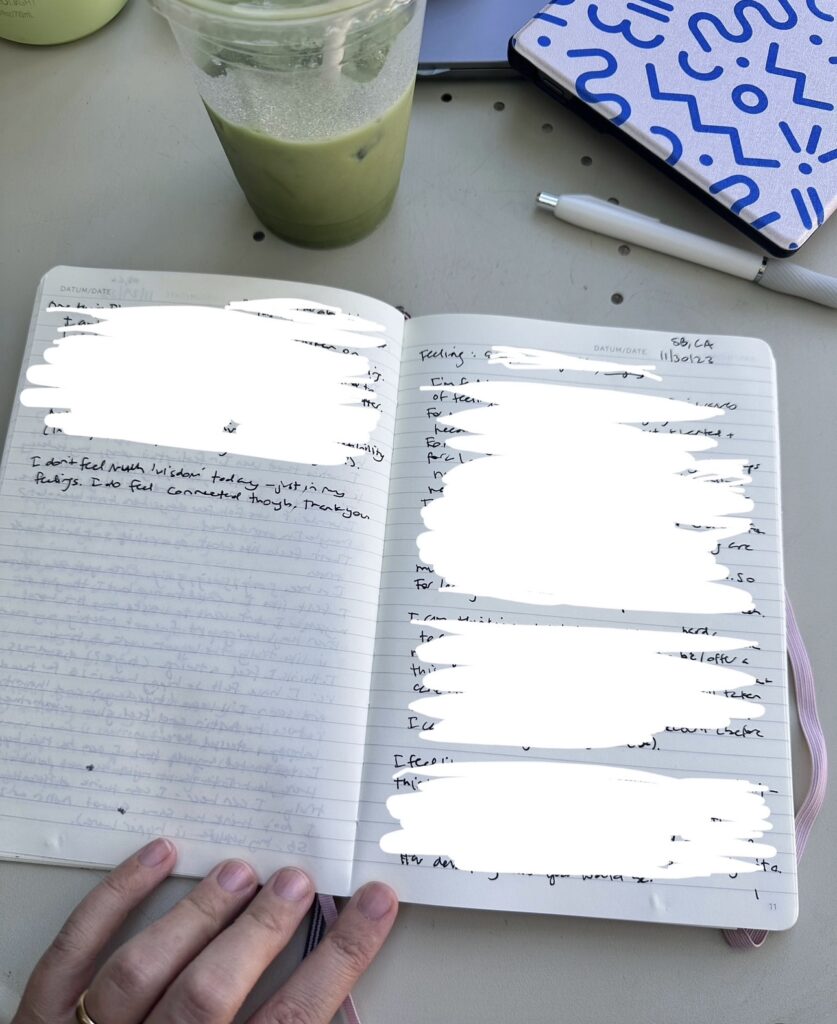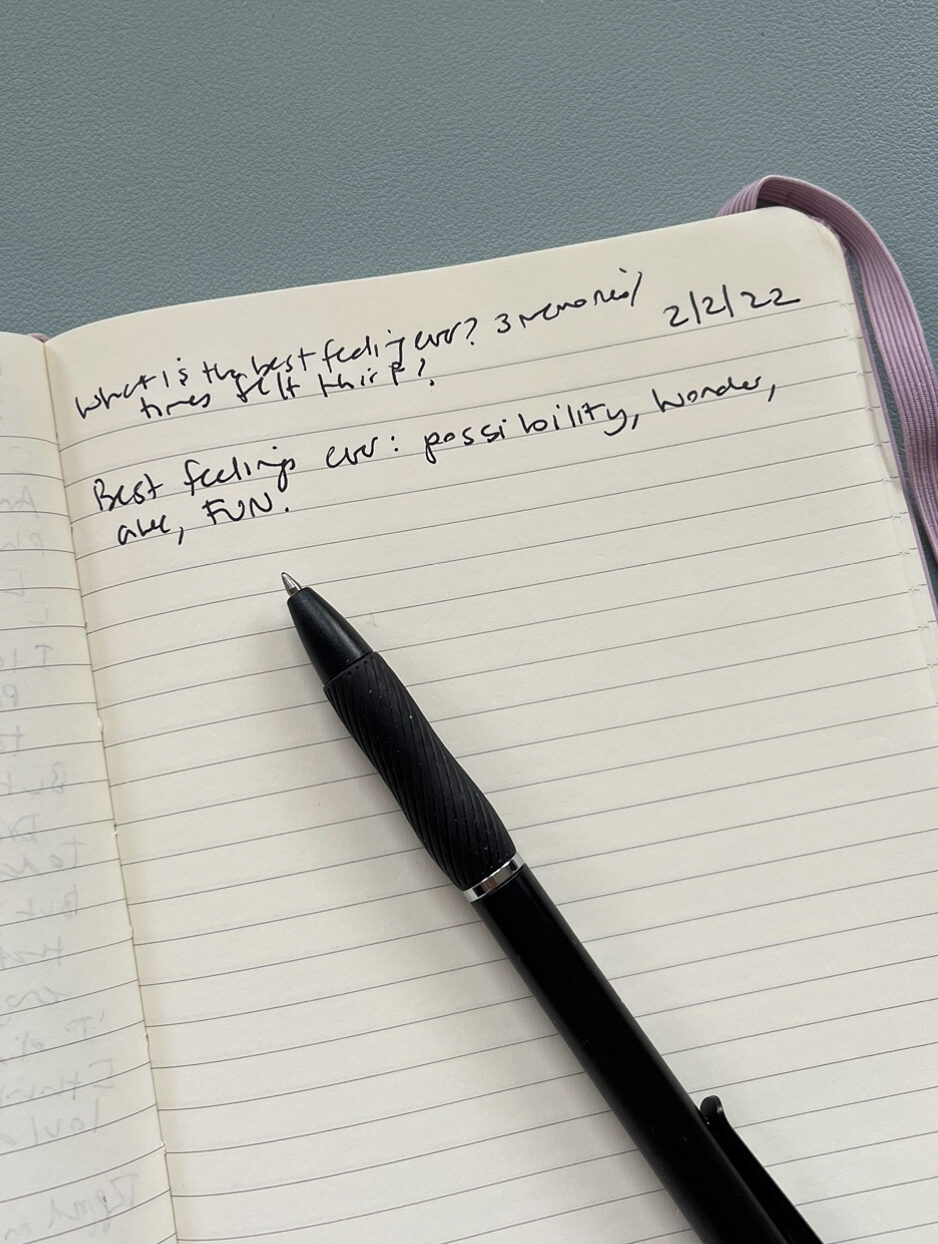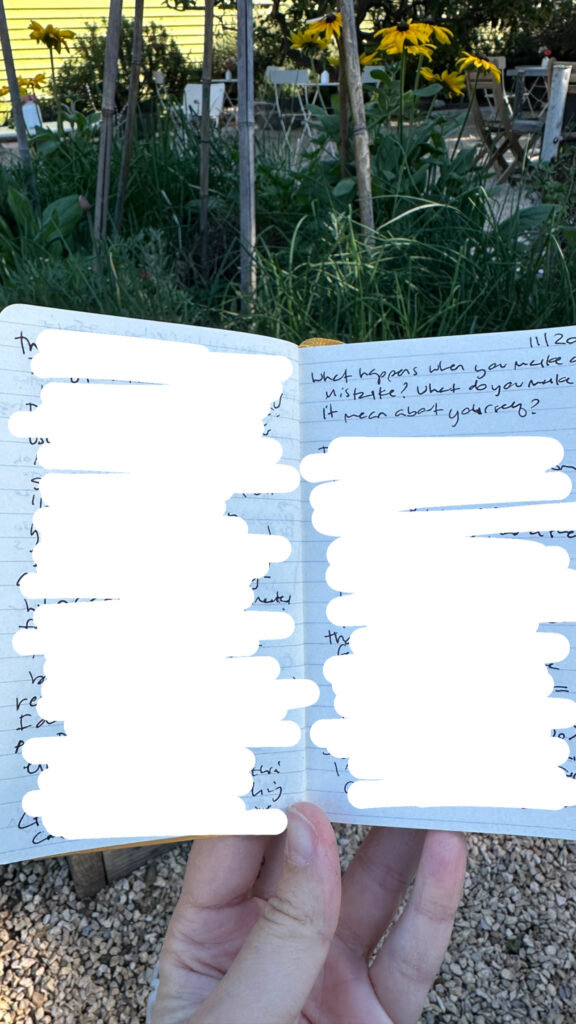Becoming a Regular Journaler
I have wanted to be a regular journaler since my teenage years, and after many attempts (and notebooks purchased and discarded, failed attempts, and beating myself up), I *finally* uncovered the process that works for me. I have now been a very consistent journaler for four years now. I have actually filled entire notebooks! No more buying notebooks and then guiltily looking at the stack of untouched notebooks (or worse – written in twice and then discarded for a shiny, new notebook).
This is possible for you too.
How do I know?
Because I used to identify as an inconsistent person – “why can’t I just stick with something?!”.
A LOT has gone into changing my inconsistent-person-identity.
Half of the work is practicing your new habit, and maybe more than half is shifting your identity to someone who writes (or whatever habit you want to have).
A VERY IMPORTANT NOTE
I just want to say something very, very important right here before we dive in –
ALL OF MY ‘TRIES’ equaled finally figuring out MY way of having xyz habit.
EVERY habit I’ve successfully established (listed above + more) – each of them came from many ‘tries’ and ‘fails’. The most important part is: I kept trying until I found MY way.
All of your ‘tries’ are not failures.
They are your attempts at discovering YOUR process.
(I can’t emphasize enough how important this is).
Today I’m sharing my exact journaling process with you.
Important for you to understand – it’s the HOW.
IMO, you must link your identity with a desired habit in order to actually see success (this would be the WHY).
Uncover your WHY to Change Your Habit Identity
We all, always, want someone to tell us HOW to do something.
But the real changes happen when you uncover your unique WHY for doing it. Why does this really matter to you? What will it mean to be someone who has a consistent xyz habit?
Uncover your answers to those questions and you will discover the desire within yourself to be someone who does xyz consistently.
That’s how to make it stick.
Ok that is my introductory spiel, let’s (briefly) get into my journaling WHY and then onto my exact journaling process!
My WHY for Consistent Journaling
I do not personally enjoy ranting for three handwritten pages. I want to feel good/better after writing! Or at least, I want the experience to be cathartic. I don’t want to finish writing feeling mired in heavy, sucky feelings. I’ve learned this through trial and error (and my many ‘tries’).
But, I often come to the page feeling overwhelmed/low/sad/discontent/despair/confusion/longing (and more).
Side note: THIS ^ is my WHY for having a consistent writing habit.
I do not want to move through my life with cloudy weather hanging over me 24/7.
I have a brain that skews very negative due to past traumas and developmental experiences. And I suffer a lot when my mind is uncontained and allowed to run the show. Writing allows me to unpack what’s circling around in my head, check in with how I’m feeling, look for connections, rant until it’s all out, and then finally – (this is the magic) – I start to feel whispers of curiosity, awe, and wonder.
Consistent journaling (what I called ‘Daily-ish Writing’) is one of my go-to tools to tame my mind – but moreso, to befriend myself. I have gone from someone who wants to ‘fix themself’ to someone who deeply wants to know themself, understand their inner workings, and befriend myself (present me, and all the past versions of myself that I carry around with me everywhere I go!).
Let’s Dive Into My Exact Journaling Process
What to expect:
- I’ll start by listing My Tools
- Then I’ll share My Exact Journaling Process
- Then include some Writing Habit Tips for you to consider
- Finally, there will be Footnotes for you with final details (denoted by *)
- At the very end I’ll include some Photos of my writing in my notebooks so you can see visuals of everything I’m sharing in this article
I’ll start by saying that my process has evolved, but the roots have stayed much the same for a few years now. My unique journaling process is different from anything I’ve ever encountered before – it is supportive, thoughtful, and all about getting to know yourself (like you would a cherished friend).
VERY IMPORTANT: Please – take what serves you in this article, and leave the rest. Try it my way and see how it feels for you. Keep what resonates, and leave the rest behind. Do not try to do it ‘perfectly’ my way – use all of this information as a resource to respond to. Give it a try, and see what YOUR inner wisdom likes/doesn’t like/wants to keep/wants to ditch. Please do not use any of this against yourself (or anything I share – ever).
My Tools
Daily Writing:
Moleskine lined notebook, soft cover, size large (5.5” x 8.25”)
Sharpie S-Gel Pen, .7mm, black ink
Walkabout Notebook:
Moleskine lined notebook, hard cover, size pocket (3.5” x 5.5”)*
Sharpie S-Gel Pen, .7mm, black ink
Spacious, Inquisitive Writing Prompts
I’ll include a plug for my Daily Writing Prompts here as I have found it immensely helpful to have a thoughtful question to consider in my writing. Each prompt (there are 366 that are delivered every night for a year while you sleep) is designed to uncover what you want, what you believe is possible for you, and what’s in the way right now. You do not need these prompts! You can follow the process I outline here as I have. But I developed these prompts for myself over the course of a year and I (and many others) love writing to them.**
My Exact Journaling Process
I have never shared my exact process before! But I had the inspired calling to get really granular and share it step-by-step, so here we go:
1. How I Begin
I always write on the right hand page first, then on the left hand page for page 2, the next right hand page for page 3, the accompanying left hand page for page 4, etc.***
2. Setting Up the Page
I write the date in the upper right hand corner of the first (right hand side) page, along with where I am if I’m not at home. I also write the page number (that I’ve written that day) in the lower outside corner of the page (ie ‘1’ on the lower right hand corner of page 1, ‘2’ on the lower left hand corner of the page I’ve written, and so on).
3. How I Start Writing
3A. If I’m noticing strong feelings: I write ‘Feeling: _____, ______, _____’) on the first line and list out my dominant feelings
3B. If I’m noticing strong/looping thoughts: I write ‘Thinking about: _______________’) on the first line and list out my dominant thoughts/what I’m thinking about/ruminating on
4. Being on My Own Side (always)
I aim to write subjectively, but on my own side, and very much in touch with what is going on inside of me. Like how I would listen to a cherished friend tell me about something that’s up with them. Sometimes I rant, whine, complain, blame, etc. BUT! I never stay, or stop, there. I like to think about getting it all out, until I feel like a *gently* wrung out towel…
5. Writing is a Practice of Attunement
Once I feel like I’ve gotten the core of it out – and please understand – journaling for me is a practice of ATTUNEMENT to myself – so I am also engaging with myself as I write. It is like a dialogue with myself – the part of me who is discontent/questioning/hurting/confused/worrying and the deep part of who is wise. It is almost like a mindfulness practice – except I am writing it down (getting it out is so important!) AND I am engaging with the part of me who is feeling things. I do not just record it all down like a robot, I want to tend to that part of myself. Remember – my goal is to BEFRIEND myself!
“I don’t know what I think until I write it down.”
Joan Didion
6. How I Dialogue with Myself in Writing
Writing is a practice of uncovering what I’m thinking and feeling, engaging with those parts of myself (“What’s going on there?”, “What feels off?”, “What am I expecting of myself?”, “What might really be going on here?”). I always write from the place of: I make sense, so what might be going on here?
I practice this compassionate inquiry until one of two things happen –
1. I land on something that feels like an ‘oof’, and also a bit of a relief to uncover/understand (like I imagine a young kid who is upset about something, and finally feels heard, and they just slumps a little, like they feel seen/heard/understood)
2. I write out how I’m feeling and/or what I’m thinking about and don’t find understanding, but I’ve gotten the rumination out of my head and onto the page
7. If I Feel a Spark of Curiosity/Awe/Inner Wisdom
Once I’ve gotten it all out, and if I’m feeling curiosity/maybe some awe, I begin to tap into the inner wisdom that now feels available. I ask myself questions like: “What do I really want here?”, “How do I want to ‘be’ in my life?”, “What would I tell someone else about this?”, “What would I tell my five year old self about this?”, etc.
8. Ending the Writing Session
Please note – you did not do anything wrong if you don’t feel that spark of curiosity/awe/inner wisdom. Some days I don’t get there, especially when I’m really going through something. It is always so helpful to write out what’s in your head and what you’re feeling – the goal is never to get somewhere, or get something out of it. If I don’t feel that spark of curiosity/awe/inner wisdom, then I end by expressing gratitude – to myself for tending to myself, the universe for the opportunity to be here alive at this time, to anyone that is contributing meaningfully to my life while I’m in it (I literally write THANK YOU on the page, and really feel the expression of gratitude towards myself, the universe, another person, a place, etc.)
9. That’s it!
That is my exact writing practice. I do it daily-ish – meaning most days to every-other-day or so. I’m not strict with myself and I don’t force myself to write, ever. I want to cultivate the DESIRE to write, so that it is part of my identity. I don’t want to force myself to write out of obedience. I keep writing top of mind for myself – it is one of the habits I practice most frequently – and I sit with doing the practice of writing until I feel the spark of desire to do so.****
Writing Habit Tips
Set Yourself Up for Success by Writing One Page:
When you’re starting a consistent writing practice – be a good friend to yourself and have the goal of writing one page.
- That’s one page in a large sized notebook, medium, or pocket sized. One page is one page.
- The goal is never the quantity of writing you do – it is to fulfill the process of tending to what’s present for you until it’s all out, then tapping into curiosity/wonder/awe (even momentarily)
If You Procrastinate:
If you procrastinate or resist writing consistently – limit how much you allow yourself to write.
- Instead of: “Ugh I ‘have to’ write three handwritten pages every morning”
- Try this: “I’m only allowed to write one page today”.
- Stick to it! Limit yourself. Notice if you feel more desire to write when you give yourself a parameter (rather than a wide open goal). Or – write one page (a writing prompt can help) and celebrate yourself for showing up for yourself and your habit today!
If You Feel Overwhelmed to Start:
Tip 1 – If you experience overwhelm to begin writing – write in a smaller notebook.
- Seriously. My favorite notebook size (after lots of experimentation, like a ridiculous amount) is a 5” x 8.25” notebook. On days when I want to write but feel overwhelm about starting, I write in my ‘walkabout’ notebook (which is 3.5” x 5.5”).
- Years ago, I would not have thought I’d like writing in a small notebook, but I really do. The smaller size feels less daunting, and it feels kind of fun to write many pages. Gamifying helps when resistance is present!
Tip 2 – If you experience overwhelm to begin writing – time yourself
- I did this as I built my daily-ish writing habit. I started the stopwatch on my phone and kept track of time to see how long one page took me to write. Not to compete or to write as fast as possible – but to show myself that it actually takes very little time write one page (usually 8-11 minutes)
Leave ‘Gas in the Tank’:
- ALWAYS, always leave some ‘gas in the tank’. Do not write until exhaustion – it will make it very hard to practice your habit tomorrow. This is why I am an advocate of writing one page per day as you establish YOUR writing habit.
Footnotes:
*The pocket size notebook fits perfectly in a lululemon everywhere belt bag, small purse, pocket, etc. I like to always have a notebook with me so I can honor my *inspired calling* to write whenever I feel the nudge. I also write in my pocket sized notebook when I feel overwhelmed to begin writing (this tip works like a charm every time).
**This is truly all you need to know to implement major (or minor) change in your life. I have worked with so many people who do not know what they want, and there is often great grief in that. Uncovering what you want, what you do (and don’t believe) is possible for you, and what’s in the way right now is a truly transformative tool for creating lasting change in your life.
***Why do I do this? The answer is: I don’t really know. I probably started one day writing on the right hand page, then wanted to write an additional page so wrote on the left hand page, and boom – a habit was started. I do like writing in this off-pattern because it is different from how we typically read/write – and I think that’s a good thing. If you can’t stand the idea of doing this – don’t! This is just how I do it, and I like it so I continue to. Again, here are the: Daily Writing Prompts
****In the beginning, when I was building my writing habit, I did practice the habit of writing even when I didn’t feel like it. I offer tips on how to gamify writing for yourself under the Tips section to get you over the resistance hump. But please know yourself – if you’re feeling resistance frequently – why? What might be going on? It is not because you’re lazy or inconsistent – there are reasons why you don’t want to do something that you very much want to do. Uncover WHY that is and construct your writing habit to be SUPPORTIVE of you (rather than something you use against yourself or force yourself to do out of obedience).
Wrapping Up
This is my exact journaling process – how I show up to the page and write most days. I hope that you take what serves you here, and leave the rest. You know yourself – and you can trust what your inner self is telling you (that you like, don’t like, want, need, etc.).
I do suggest giving yourself a month to practice daily-ish writing – experiment with everything I’ve offered here. Building a sustainable habit takes some time – give yourself the gift of focusing on this one thing for 30 days and see where it takes you.
Writing is a beautiful tool that adds so much to my life. I really resonate with the Joan Didion’s quote I shared, “I don’t know what I think until I write it down”. Let’s discover what we really think (and feel) by practicing the offering of daily-ish writing so we’re clear on what really matters to us.
Photos
Here are a handful of photos so you can see visually how I lay out my notebook and my writing, as well as examples of prompts that I write to.
